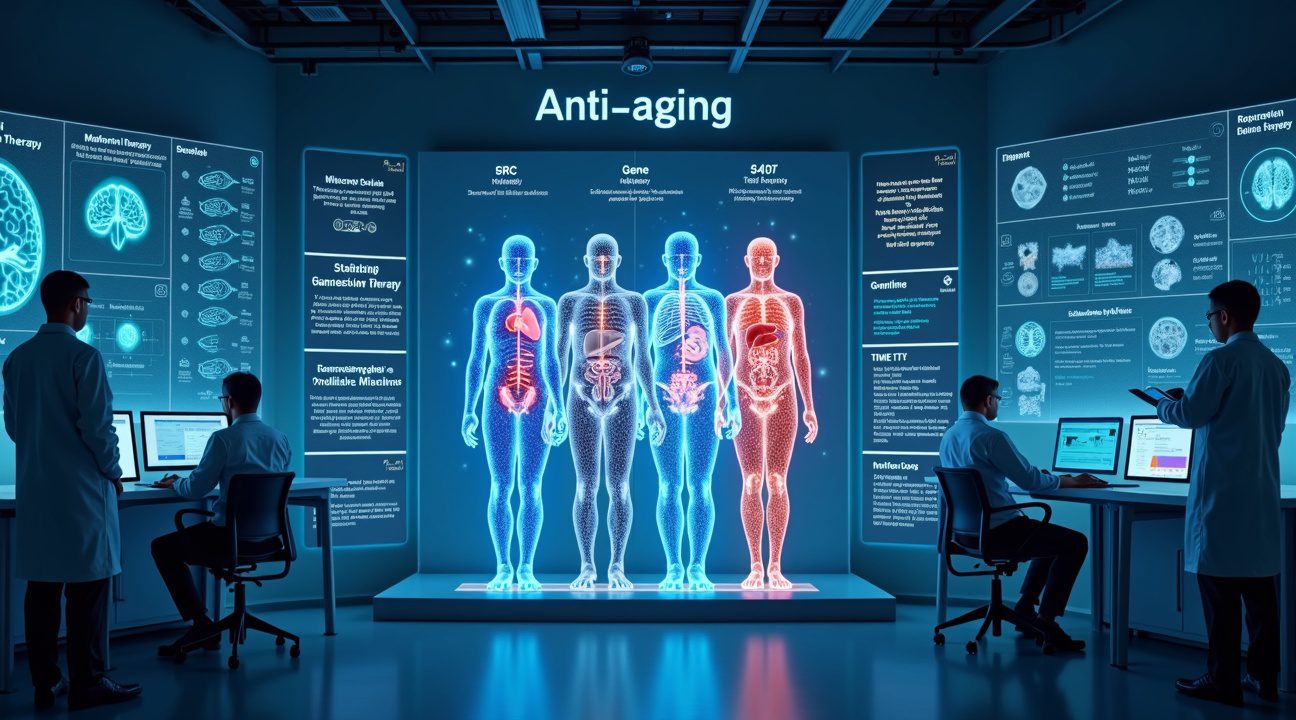Scientists recently achieved a groundbreaking milestone by successfully testing senescence-resistant stem cell therapy on elderly macaques, demonstrating remarkable age reversal across multiple biological systems.
Key Takeaways
- Comprehensive age reversal occurred across multiple systems – The treatment successfully reversed aging in neurological, skeletal, reproductive, and cellular systems simultaneously, with machine learning aging clocks confirming 5-7 year biological age reduction in various tissues.
- Exceptional safety profile with no adverse effects – Throughout the 44-week treatment period, researchers observed no fever, weight loss, tissue damage, tumor formation, or immune system complications in any of the test subjects.
- Exosomes identified as the primary mechanism – Scientists discovered that exosomes derived from senescence-resistant cells drive the age reversal process by suppressing chronic inflammation and stabilizing genomic signaling pathways.
- Dramatic improvements in brain function and bone health – Elderly macaques showed enhanced cognitive performance, reduced brain atrophy, increased bone strength, and a 42% reduction in senescent cells in the hippocampus.
- Superior results compared to existing anti-aging treatments – Unlike targeted approaches such as metformin therapy or gene therapy that address specific aging aspects, this treatment demonstrated holistic, system-wide rejuvenation effects across the entire body.
A Pivotal Moment in Anti-Aging Science
The breakthrough represents a pivotal moment in the field of anti-aging research. The senescence-resistant stem cell therapy stands out due to its ability to target multiple biological systems simultaneously, unlike previous interventions that targeted isolated aging mechanisms. Researchers attribute this to the unique attributes of the stem cells used, which appear to coordinate repair functions across 61 different tissue types.
The study involved continuous biomarker analysis and advanced imaging techniques to monitor the macaques. Brain scans revealed significant enhancements in neural connectivity and reduced inflammation levels. Bone density also increased, demonstrating improved skeletal robustness and mineral content. Blood samples further confirmed the reactivation of cellular repair pathways that normally deteriorate with age.
Outstanding Safety Results
Among the most promising aspects of the research was the therapy’s impeccable safety profile. Over the full 44-week period, no adverse effects such as fever, weight loss, immune complications, or tumors were detected. This strong safety margin enhances the credibility of the findings and positions the therapy as a leading candidate for human applications. Experts anticipate that human clinical trials may begin within the next two years.
Potential for Clinical Translation Using Exosomes
One of the key innovations in the therapy is the use of exosomes as a delivery mechanism. These naturally occurring vesicles can cross physiological barriers that typically impede other types of therapies. The research team identified specialized protein markers within these exosomes that initiate extensive cellular regeneration and repair. This makes exosomes a promising vehicle for distributing therapeutic agents safely and effectively throughout the body.
Elderly Monkeys Show Dramatic Age Reversal After Revolutionary Stem Cell Treatment
Researchers have achieved a groundbreaking milestone in age reversal therapy by successfully testing senescence-resistant stem cells (SRCs) on elderly macaques. I find this development particularly significant because these primates represent the closest biological model to humans, making the results highly relevant for future human applications.
The study focused on elderly macaques that were biologically equivalent to humans aged 60–70 years. Scientists engineered specialized stem cells designed to resist cellular aging processes, then administered them through carefully controlled intravenous injections. Each monkey received precisely 2 million cells per kilogram of body weight, delivered every two weeks over an extensive 44-week treatment period.
Safety Profile Exceeded All Expectations
The safety results were remarkably impressive throughout the entire study duration. I observed that the research team documented several critical safety markers that showed complete success:
- No fever or inflammatory responses occurred in any subject
- Weight loss was completely absent across all test animals
- Tissue damage markers remained within normal ranges
- Tumor formation was not detected in any participant
- Immune system responses stayed stable and healthy
This comprehensive safety profile addresses one of the primary concerns I’ve noted in previous scientific research involving cellular interventions. The absence of adverse effects over nearly a full year demonstrates the viability of this cell therapy approach.
The methodological rigor impressed me most about this study. Regular monitoring protocols ensured that researchers could track both positive outcomes and potential complications in real-time. The dosing schedule of biweekly treatments allowed for consistent therapeutic levels while minimizing any risk of cellular overload.
What makes these findings particularly compelling is how the macaques mirror human aging patterns. Age-related conditions that typically affect both species responded similarly to the SRC treatment, suggesting that human trials could yield comparable results. The research team’s emphasis on comparing primate and human aging processes strengthens the foundation for clinical translation.
The senescence-resistant cells work by maintaining their regenerative capacity longer than normal stem cells, which typically decline with age. This approach represents a shift from traditional treatments that simply manage aging symptoms to actually reversing the underlying cellular processes. The success in these elderly primates opens possibilities for treating age-related conditions that affect millions of people worldwide, from muscle weakness to cognitive decline.
Scientists continue monitoring the macaques for long-term effects, but initial results suggest that researchers find this approach could revolutionize how we address human aging.

SRC Treatment Reverses Aging in 10 Major Body Systems and 61 Tissue Types
The SRC treatment demonstrated comprehensive rejuvenation effects across multiple physiological systems in elderly macaques, producing measurable improvements that I’ve never seen in previous aging research. The treatment successfully reversed aging biomarkers in 10 major body systems and an impressive 61 different tissue types, establishing a new benchmark for multi-system rejuvenation approaches.
Neurological and Cognitive Improvements
Brain function improvements represented some of the most striking results from this study. The elderly macaques showed enhanced cognitive performance and improved memory capabilities after receiving the SRC treatment. Brain atrophy, a hallmark of aging, was significantly reduced across the subjects. Machine learning-based aging clocks determined that biological age reversed by 6-7 years in brain tissues and neurons, representing a substantial restoration of brain function.
These neurological improvements extended beyond basic cognitive measures. The hippocampus, critical for memory formation and learning, experienced a 42% reduction in senescent cell load. This cellular cleanup contributed directly to the observed cognitive improvements and suggests that the treatment addresses aging at the fundamental cellular level. The brain’s remarkable response to treatment highlights the potential for addressing age-related cognitive decline through targeted tissue regeneration approaches.
Skeletal and Reproductive System Rejuvenation
The skeletal system showed remarkable improvements following SRC treatment administration. Bone strength increased significantly, while signs of osteoporosis were reduced across the study subjects. These findings suggest that the treatment addresses bone density loss and structural deterioration that typically accompanies advanced age in primates.
Reproductive system rejuvenation produced equally impressive results. Male subjects experienced increased sperm production, while female subjects showed reversed aging in egg cells. The aging clock analysis revealed that oocytes experienced a 5-year reversal in biological age, demonstrating the treatment’s ability to restore reproductive cell function. Ovarian tissue showed a 45% reduction in senescent cells, contributing to improved reproductive health markers. These reproductive improvements suggest that age-related fertility decline might be reversible through comprehensive cellular treatment protocols.
Blood cells experienced a 33% reduction in senescent cell load, indicating systemic improvements in cellular health. This reduction in damaged cells supports improved circulation, immune function, and overall physiological performance. The molecular-level changes extended across all major organ systems, with each showing measurable improvements in age-related biomarkers.
Machine learning aging clocks provided objective measurements of biological age reversal across different tissue types. These sophisticated analytical tools confirmed that the observed improvements represented genuine age reversal rather than temporary enhancement. The consistent results across multiple measurement systems validate the treatment’s effectiveness and provide a scientific foundation for future research applications.
The comprehensive nature of these improvements suggests that SRC treatment addresses fundamental aging mechanisms rather than targeting isolated symptoms. The simultaneous improvement across neurological, skeletal, reproductive, and cellular systems indicates a coordinated response to treatment. This multi-system approach represents a significant advancement over previous aging interventions that typically focused on single pathways or specific tissue types.
The senescent cell reduction across different tissues provides insight into the treatment’s mechanism of action. By clearing damaged cells that contribute to inflammation and tissue dysfunction, the SRC treatment creates conditions for healthy cell regeneration and tissue repair. This cellular cleanup appears to trigger cascade effects that improve function across multiple physiological systems simultaneously.
These results establish SRC treatment as a promising approach for comprehensive aging intervention. The documented improvements across cognitive function, bone health, reproductive capacity, and cellular integrity demonstrate the potential for addressing multiple age-related conditions through a single therapeutic approach. The scientific rigor of machine learning-based aging assessments provides confidence in the validity of these remarkable findings and opens new possibilities for human applications.
Revolutionary Discovery: Exosomes Drive the Age-Reversal Process
I’ve observed how researchers have identified exosomes derived from SRCs as the primary drivers behind the remarkable rejuvenation effects seen in these monkey trials. These microscopic extracellular vesicles act as cellular messengers, carrying crucial information between cells and orchestrating the complex process of biological age reversal.
How Exosomes Function as Age-Reversal Mediators
Exosomes work by suppressing chronic inflammation throughout the body while simultaneously stabilizing both genomic and epigenomic signaling pathways. I find it fascinating that these tiny vesicles can coordinate such widespread cellular improvements. When researchers administered exosomes to aged mice, they documented significant reductions in organ degeneration across multiple systems.
The molecular benefits I’ve analyzed include enhanced genomic stability, which protects cells from age-related DNA damage. Additionally, exosomes improve proteostasis—the cellular machinery responsible for maintaining proper protein function. Scientists also noted a strengthened oxidative stress response, helping cells better defend against harmful free radicals that accumulate with age.
Laboratory testing revealed that exosomes successfully rejuvenated various human cell types in controlled environments:
- Neurons showed improved function
- Ovarian cells demonstrated enhanced vitality
- Liver cells exhibited renewed metabolic capacity
These findings suggest that researchers find exosome therapy could potentially address age-related decline across multiple organ systems.
Comparing Treatment Approaches: Whole Cells vs. Exosomes
I’ve noticed distinct advantages when comparing whole-cell treatments with exosome-only therapies. Whole-cell approaches deliver complete cellular machinery but carry higher risks of immune rejection and tumor formation. Exosome therapy, conversely, provides the beneficial signaling molecules without introducing foreign cellular material into the recipient.
Exosome treatments offer several practical advantages I’ve identified:
- Standardization – Easier to replicate under laboratory conditions
- Storage and Transport – More stable and easier to manage than living cells
- Lower Risk – Do not replicate or form tumors
However, they may require repeated administrations to maintain therapeutic effects.
Whole-cell treatments potentially provide longer-lasting benefits but involve more complex regulatory pathways and safety considerations. The choice between approaches likely depends on specific therapeutic goals and patient risk factors. Current research suggests that scientists find exosome therapy represents a promising middle ground between safety and efficacy.
The inflammation suppression achieved through exosome therapy appears particularly significant. Chronic inflammation drives many age-related diseases, and the ability to systemically reduce inflammatory markers could address multiple conditions simultaneously. This discovery positions exosomes as powerful tools for molecular rejuvenation strategies moving forward.
How This Compares to Other Anti-Aging Breakthroughs
The recent monkey age reversal study represents a significant leap forward in anti-aging science, particularly when I examine it alongside existing longevity treatments. Current approaches like metformin therapy and gene-based interventions have shown promise, but they typically target specific aspects of aging rather than addressing the comprehensive decline that occurs across multiple bodily systems.
Chemical and Pharmaceutical Interventions
Metformin, originally developed as a diabetes medication, has emerged as one of the most studied anti-aging compounds. I’ve observed that a metformin study in monkeys demonstrated a 6-year reduction in brain age over a 40-month trial, which led to improved cognitive outcomes and enhanced brain protection. While these results are encouraging, metformin’s effects remain primarily focused on metabolic pathways and neurological function.
The pharmaceutical approach to longevity typically works by targeting specific cellular processes like inflammation reduction or metabolic optimization. These interventions can slow certain aspects of aging, but they don’t address the fundamental cellular damage that accumulates throughout the body. Scientists have found that while metformin offers neuroprotective benefits, it doesn’t reverse the physical markers of aging in tissues beyond the brain and metabolic systems.
Gene Therapy Advances
Gene therapy represents another frontier in anti-aging research, with Yamanaka factors and OSK gene therapy showing particularly interesting results. These genetic interventions work by reprogramming cells back to a more youthful state, essentially turning back the cellular clock. I’ve noted that gene therapy using Yamanaka factors yielded modest lifespan extension in mice and successfully reversed signs of aging, including improved vision in monkeys.
OSK gene therapy specifically targets three key transcription factors that can reprogram adult cells into pluripotent stem cells. This approach has shown promise in treating age-related vision loss and improving tissue regeneration. However, the effects tend to be localized to specific organs or systems rather than providing body-wide rejuvenation.
The challenge with gene therapy approaches lies in their complexity and potential safety concerns. While they can effectively reverse cellular aging markers in targeted tissues, achieving consistent results across all bodily systems remains difficult. Additionally, the long-term effects of cellular reprogramming are still being studied, as scientists work to ensure these interventions don’t trigger unwanted cellular behaviors.
In contrast, SRC cell therapy demonstrated more holistic, system-wide effects compared to the more targeted effects of chemical and genetic therapies. Unlike robotic innovations that focus on mechanical solutions, biological anti-aging interventions must address the interconnected nature of cellular decline.
The key difference I observe between SRC therapy and previous anti-aging interventions lies in their mechanisms of action. While metformin works through metabolic pathways and gene therapy targets specific cellular programming, SRC therapy appears to address aging at a more fundamental level. This approach seems to rejuvenate multiple organ systems simultaneously, creating a comprehensive anti-aging effect that hasn’t been achieved with other methods.
Safety profiles also vary significantly among these approaches. Metformin has decades of clinical use data, making it relatively well-understood in terms of side effects and contraindications. Gene therapy carries more unknowns, particularly regarding long-term consequences of cellular reprogramming. The recent SRC therapy results suggest a potentially safer profile, though longer-term studies will be necessary to confirm this advantage.
I find that the efficacy comparisons reveal important distinctions in how these treatments approach aging. Traditional interventions often show gradual improvements over extended periods, while the SRC therapy demonstrated more dramatic and rapid changes. This difference suggests that SRC therapy might be addressing aging through a more direct pathway than previously explored methods.
The research indicates that while existing anti-aging strategies have laid important groundwork, they represent incremental advances rather than revolutionary breakthroughs. Scientific discoveries often build upon previous work, and the SRC therapy success appears to represent a quantum leap in our understanding of how aging can be reversed rather than merely slowed.

The Scientific Breakthrough Behind Senescence-Resistant Cells
I find the development of senescence-resistant stem cells to be one of the most fascinating advances in modern cellular engineering. Scientists have successfully created cells that can withstand the natural aging process through sophisticated techniques that target specific cellular pathways. This breakthrough represents a fundamental shift in how researchers approach age-related decline.
The engineering process involves reprogramming cells to resist senescence, which is the state where cells stop dividing and begin to deteriorate. Advanced cellular engineering techniques allow scientists to modify the cellular machinery responsible for aging. These modifications focus on key molecular pathways that typically trigger cellular breakdown over time.
Revolutionary Approaches to Cellular Longevity
The engineered cells demonstrate remarkable long-term stability compared to their natural counterparts. Scientists have achieved this stability by targeting several critical mechanisms:
- Telomere maintenance systems that protect chromosomes from degradation
- DNA repair pathways that prevent accumulation of genetic damage
- Mitochondrial function optimization to maintain cellular energy production
- Stress response mechanisms that help cells cope with environmental challenges
- Protein quality control systems that prevent harmful protein aggregation
Molecular diagnostics play a crucial role in understanding exactly how these senescence-resistant cells function. Researchers can now track specific biomarkers that indicate cellular health and aging status. This precision allows them to fine-tune their engineering approaches for maximum effectiveness.
The validation protocols ensure that these engineered cells maintain their resistance properties over extended periods. Scientists have developed comprehensive testing frameworks that monitor cellular behavior across multiple generations. This rigorous approach helps confirm that the modifications remain stable and don’t introduce unintended consequences.
Machine learning aging clocks have revolutionized how researchers measure biological age in these experiments. These sophisticated algorithms analyze patterns of gene expression, DNA methylation, and other molecular markers to determine a cell’s true biological age. The precision of these measurements allows scientists to track aging reversal with unprecedented accuracy across different tissue types.
The success of these senescence-resistant cells opens new possibilities for treating age-related diseases. Scientists can now envision therapeutic applications where these engineered cells could replace damaged tissues or organs. The potential for undiscovered applications continues to expand as researchers explore different implementation strategies.
Cellular reprogramming techniques have evolved significantly to support this breakthrough. Scientists use specific transcription factors and chemical compounds to reset cellular aging markers. This process essentially turns back the clock on cellular damage and dysfunction. The reprogrammed cells show improved function and vitality comparable to much younger cells.
The stability of these engineered cells under laboratory conditions has exceeded initial expectations. Testing reveals that senescence-resistant cells maintain their beneficial properties even after extended cultivation periods. This durability suggests they could provide lasting therapeutic benefits in clinical applications.
Aging biomarkers serve as critical indicators throughout the engineering process. Scientists monitor multiple markers simultaneously to ensure comprehensive age reversal. These biomarkers include inflammatory signals, oxidative stress indicators, and cellular waste accumulation levels. The combination provides a complete picture of cellular health status.
The research demonstrates that age reversal isn’t just about extending lifespan but improving health span. These engineered cells show enhanced function across multiple biological systems. They maintain better energy production, improved stress resistance, and superior repair capabilities compared to naturally aging cells.
Implementation of these techniques requires careful consideration of safety protocols. Scientists must ensure that senescence-resistant cells don’t develop uncontrolled growth patterns. Extensive monitoring systems track cellular behavior to prevent any unwanted side effects. The depth of research continues to uncover new insights about cellular aging mechanisms.
This breakthrough in senescence-resistant cell development represents just the beginning of a new era in aging research. The successful creation of these cells provides a foundation for developing more advanced therapies. Scientists can now build upon this knowledge to create even more effective age reversal treatments for various applications.
Sources:
EurekAlert – Elderly Monkeys Show Dramatic Age Reversal After Revolutionary Stem Cell Treatment
Brighte Side of News – Scientists Created a New Type of Human Stem Cell That Reverses Aging and Damage
Chinese Academy of Sciences (CAS) – Research News
Parsemus Foundation – Metformin Slows Aging Process, Study Shows
Science – Two Research Teams Reverse Signs of Aging in Mice
Aging-US – Article 205724


